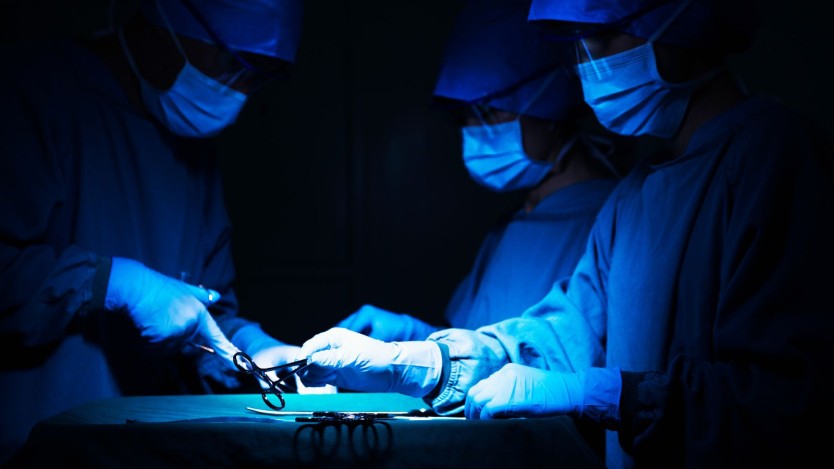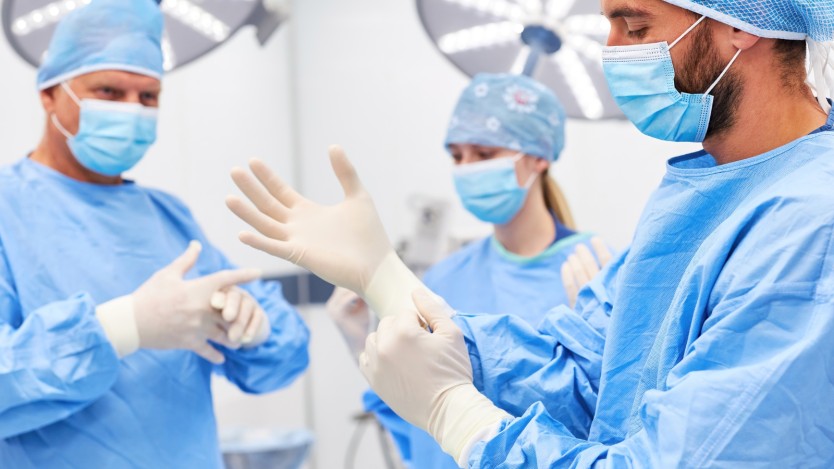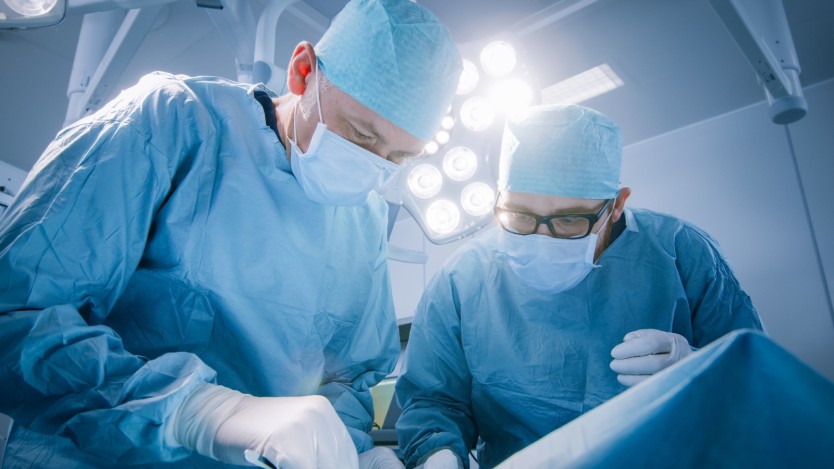Risks, Problems and Complications of Prostate surgery

- Complications of prostatectomy surgery
- Complications of TURP prostate surgery
- Complications of Thulium Laser prostate surgery
- Do you want to have prostate surgery at Operarme?
- With radical prostatectomy the patient can have orgasms without expulsion of semen through the urethra (dry orgasms).
- The occurrence of retrograde ejaculation with Laser Tulio is very rare due to the little manipulation of the tissues that is performed with this technique.
- Urolift technique preserves sexual function in 100% of cases.
Complications of prostatectomy surgery
The surgical technique of prostatectomy allows the entire prostate gland to be removed. It is indicated for prostates of any size, including large prostates and especially for large prostates. This procedure is usually reserved for cases of prostate cancer. There are three surgical approaches: open surgery, laparoscopic surgery and the Da Vinci Robot procedure.

Do you need laser prostate surgery?
Request a free and immediate appointment with our specialists
Any of them may entail some complications that must be taken into account when choosing the surgical technique, which can be divided into immediate and medium-term complications:
Possible immediate complications
This surgery is reserved for cases of prostate cancer. Normally with the removal of the prostate, the seminal vesicles are also removed, which means that the patient no longer ejaculates. This does not mean that the patient stops having orgasms. It is just that these orgasms will not be accompanied by the expulsion of seminal fluid. They will have dry orgasms.
Urinary incontinence is another complication that can occur after radical prostatectomy, regardless of the approach taken. This urinary incontinence can improve up to one year after surgery and with the help of pelvic floor rehabilitation.

Another of the most frequent complications is intraoperative bleeding, to the extent that the patient may require blood transfusions to level red blood cell concentrates and haemoglobin levels. In some cases, re-interventions are required to stop the patient from bleeding. This consists of cauterising the bleeding site via the urethra. Otherwise the patient would require serial transfusions.
Possible medium-term complications
Among the medium-term complications, the most frequent are urinary tract infections, either of the urethra or the bladder. These infections can become life-threatening days or weeks after the patient has undergone surgery. They can even produce another complication in themselves, which is an obstruction to the outflow of urine due to inflammation of the urethra, forcing the patient to be catheterised again.
Surgical wounds can also become infected, but in the same way as infections, they will turn around within days or weeks after the operation. They will be treated with the appropriate and specific antibiotic.
During the surgery, the surgeon's scalpel may inadvertently puncture the bladder wall, and over time, depending on where the injury occurred, the urine leakage will perforate the adjacent tissues, resulting in a fistula.
These fistulas can be entero-vesical, when they communicate an intestinal loop with the bladder, or recto-vesical, when it is at the level of the rectum, in the final portion of the intestine.
Erectile dysfunction is another relatively frequent complication that can be found in this type of surgery, and it is included in the medium-term complications because during the convalescence period, where the patient has to remain catheterised, it is too early to make a definitive diagnosis of erectile dysfunction in men after prostatectomy.
In the long term and due to the time spent immobilised, the patient may develop thromboembolism in a leg or in the lung, which is known as DVT or PTE (deep vein thrombosis or pulmonary thromboembolism), which is why these episodes must be prevented with specific medication prescribed by the doctor. It is usually a rare complication but should be taken into account.
Complications of TURP prostate surgery
This technique involves the removal of the prostate through the urethra. The entire prostate is removed. The size of the prostate should not exceed 80 grams.
Possible immediate complications
Among the immediate complications, the most frequent is the possibility of intraoperative bleeding with the need to transfuse the patient, up to 7% of the time.
This bleeding also leads to the creation of clots inside the bladder. These clots travel towards the urethra in an attempt to be expelled and obstruct it, causing acute urinary retention (AUR), forming what is known as a bladder balloon, which is usually very uncomfortable for the patient. For this reason, the patient remains catheterised until the urine is clear and normal in colour.

Possible medium-term complications
Among the medium-term complications of this type of intervention are urinary tract infections, which can occur in up to 10% of cases.
A relatively frequent complication is what is known as retrograde ejaculation. This is caused by resection of the seminal vesicle drainage ducts, which, when sectioned, instead of ending up in the urethra will end up in the bladder and therefore the semen will end up there. This does cause infertility in men, but it should not be confused with impotence.
Incontinence is also another complication, but we find it in a lower percentage than in the case of the radical prostatectomy technique. It occurs in approximately 1%.
In this case, DVT or PTE may also occur, so prophylactic treatment is necessary.
Complications of Thulium Laser prostate surgery
This type of technique can have very good results with prostates weighing up to 60 grams. However, larger prostates can also be operated on.
Possible immediate complications
This is one of the newest techniques for the treatment of Benign Prostatic Hypertrophy (BPH), however one of the most immediate complications is that after the technique is performed, the symptoms of BPH do not improve, loss of urinary stream strength, difficulty in urinating, need to urinate many times, etc.
This is due to the formation of urethral stricture as a complication. However, this can occur in a very, very small percentage of cases and would have a solution. The risk-benefit ratio is highly advantageous.
Intraoperative bleeding is minimal compared to the two previous techniques and therefore there is no need for transfusion. In addition, the laser technique allows photo-coagulation of any bleeding point at any time during the operation.
The possibility of perforation of the hollow viscera, bladder, intestines and rectum, and of creating a fistula, is much lower than with the other previous techniques.

Possible medium-term complications
The prostate gland is in an anatomical relationship with the glands that produce semen and when manipulation occurs, these would drain into the bladder instead of draining into the urethra for outflow. With this technique, the incidence of manipulation of the seminal glands is minimal, so the occurrence of retrograde ejaculation as a secondary complication attributable to the technique is practically non-existent.
The same can be said of erectile dysfunction, with the Thulium laser technique, the occurrence of dysfunction is statistically negligible.
Urinary tract infections may occur, but in much lower percentages than in the case of the two previous techniques.
As for urinary incontinence, it is very rare for it to appear as a complication after prostate surgery with the Thulium laser.
Urolift prostate surgery
This technique is very new and consists of urethral liberation through a device that permeabilizes the lumen of the urethra, separating the walls of the prostate that are compressing it.
The spectacular thing about this technique is that immediate and verifiable results are obtained after the technique has been carried out and that it also preserves sexual function in 100% of cases compared to the other techniques previously mentioned.
The complications of these techniques are more attributable to the anaesthesia itself than to the technique itself, and furthermore, the anaesthesia is not general anaesthesia but is performed under sedation, which means that the anaesthetic risks are negligible.
Possible immediate complications
Some intraoperative bleeding may occur, but it is so rare that it is hardly worth mentioning. In no known case has a patient ever required transfusion.
Possible medium-term complications
There are no complications of erectile dysfunction, urinary incontinence, perforation of the hollow viscera or fistula, etc.
There may be a case of urinary tract infection, but the risk is so low that one would not know whether to attribute it to the operation itself or not, because the frequency is so low that it is close to the percentage of urinary tract infection in the general population that has not undergone the operation.
The disadvantage, rather than a complication, is that the prostate may continue to grow and may eventually require surgery to reduce the size of the prostate.
However, it is currently the most recommended technique for BPH, as far as complications are concerned, provided that the patient can benefit from the technique, as not all prostates can benefit from it. This is why your urologist will tell you which technique is the most advisable in your case.

Do you want to have prostate surgery at Operarme?
You can request a free and immediate surgical assessment consultation with our urology specialist by clicking below:

Do you need laser prostate surgery?
Request a free and immediate appointment with our specialists in Urology
Medical disclaimer: All the published content in Operarme is intended to disseminate reliable medical information to the general public, and is reviewed by healthcare professionals. In any case should this information be used to perform a diagnosis, indicate a treatment, or replace the medical assessment of a professional in a face to face consultation. Find more information in the links below:
